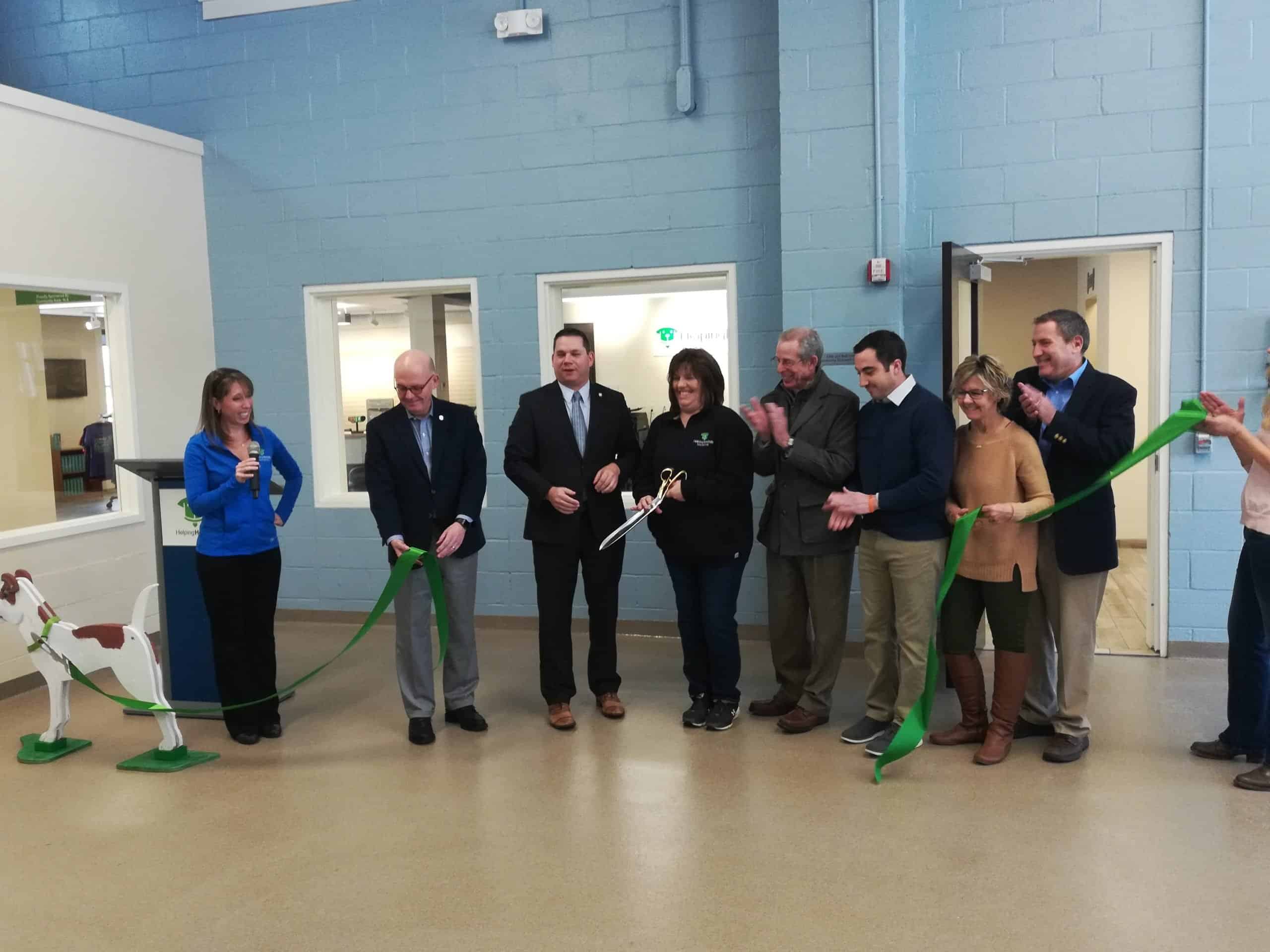Taking Animal Rescue To The Next Level
How a small group of CNY residents grew an idea into a thriving and innovative nonprofit.
Helping Hounds Dog Rescue is having a moment. What began in 2009 as a few concerned volunteers pitching in to save a beagle and her puppies from being euthanized has turned into a mature nonprofit that is in the midst of constructing a state-of-the-art 9,000 square foot facility. Once opened, it will be one of the largest animal rescue centers of its kind in Syracuse. The story of how they arrived at this point reveals how a passion project can be leveraged into a self-sustaining organization that has a powerful impact within the community it serves.
“I fell in love with the dogs, I fell in love with the mission,” says Kathy Gilmour about why she joined Helping Hounds in 2012; she is the currently the Director. “I wanted to do more.” She speaks candidly about the challenges the organization faced early on in their development.

A visitor pets a Service Dog in Training at the new Helping Hounds facility in North Syracuse.
With a small number of volunteers and a massive range of tasks to complete, it was extremely difficult to establish defined roles for everyone. “For an organization in its infancy, lines are blurred,” she explains. As the demand for adoptions grew and more and more dogs began arriving, they began to look at how to build an organizational structure that would support the growth they hoped to achieve. Helping Hounds was attracting more interest and support from the community and The Gifford Foundation had provided an early grant which allowed them to purchase special volunteer management software. Despite that early progress, there was still a lot of work to be done.
At the same time that this was unfolding, The Gifford Foundation launched their POWER program – a capacity building initiative that takes select organizations through a 12 month process designed to improve their strength and efficiency during the early stages of their development. In 2016, Helping Hounds graduated from the program along with four other organizations. “POWER made us take a hard look at everything,” says Gilmour as she reflects on the experience, “[It] helped us build a solid organization and gave us a strategic thinking mindset.”
The POWER program teaches participants to view their organization’s development as part of a larger series of phases. All nonprofits pass through different phases of growth that help define their strength, priorities, and potential for growth. This perspective, known as the Lifecycle approach, teaches nonprofits to understand their current status as part of a larger process. By anticipating what phases come next, they are better poised to self-evaluate, anticipate future challenges, and establish realistic goals.

Helping Hounds Executive Director Kathy Gilmour cuts the ribbon for the new facility with Onondaga County Executive Ryan McMahon.
When Helping Hounds began to take a hard look at its current resources versus where they hoped to be, they realized that they would have to move to a different space. The POWER program helped them identify the specific ways in which their old space was holding them back, and gave them a clearer idea of what features to look for when evaluating new locations. They had been careful to save and invest the donations they had accumulated over the years since their inception, and launched a capital contributions campaign to raise even more funds for the move.
As luck would have it, they found a space in Liverpool that is more than three times the size of the space they had been renting within ShoppingTown Mall. The new area features brand new dog houses – styled to represent homes lining a suburban street. Each is equipped with an automatic flushing system to help keep it clean and prevent waste from building up.
The new facility also includes special rooms for training seminars, kids’ birthday parties, and a quiet space for dogs who are stressed and need a place to relax. One new feature that Gilmour is particularly proud of is a respite facility for taking care of dogs when their owners are facing a crisis. “It could be a woman escaping domestic violence, or a senior who needs to go in for medical care,” she explains. Situations like these can heavily disrupt a dog’s life, and in extreme cases, can result in canine homelessness. Now, Helping Hounds will be better equipped to provide a temporary home for the dog while the owner reestablishes themselves.
Nearly 85% of the dogs that Helping Hounds rescues come from Texas or Alabama. Over time, they have built connections down south and work to provide those shelters with an alternative to euthanasia. “The South has an overpopulation problem with dogs,” says Gilmour, explaining that a lack of spaying and neutering along with a year-round breeding climate are the primary contributors. Helping Hounds currently facilitates roughly 1,800 adoptions per year through a selective process that brings in nearly 5,000 applications annually. “We thought we were so cool when our first delivery of three dogs came!” says Gilmour, “Now we get 60 at a time.”

Workers install counter tops in the new 9,000 square foot Helping Hounds facility.
Many of these dogs arrive with heartbreaking histories. Gilmour tells the story of one dog brought up from Texas who had been regularly beaten by the owner for jumping over the fence and into the neighbor’s yard. After a particularly bad beating, the dog was taken to a shelter and finally brought up north to Helping Hounds. Now, it has been trained and works as a service dog for a local veteran.
Every Saturday at noon, the new dogs who have arrived from their long journey north are presented for adoption. Each time, the line stretches out the door as people from across Central New York come to meet their next pet. In some cases, people come from as far away as Maine, Vermont, and even Canada. Rather than providing a one-time service Gilmour hopes to build a longstanding and supportive relationship between her organization and the owners. “We don’t want to lose touch with you once you’ve picked up your dog,” she says. As Helping Hands enters this new phase in its development, their impact is sure to expand even further as they help place more and more endangered dogs into new homes.


